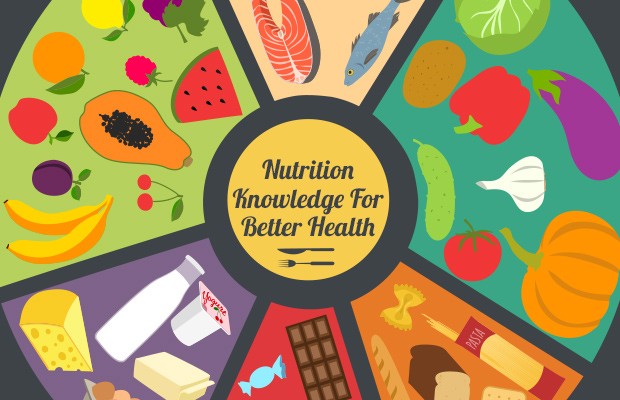Nutrition Knowledge For Better Health

You’ve likely heard the saying: an ounce of prevention is worth a pound of cure. This is especially true when dealing with one of our most precious resources, our health. As we conduct more and more research about disease, the secret to health becomes clearer and simpler. Eat right and exercise, do both consistently. Many of our most prevalent diseases are not a result of genetics or environment, but of long-term lifestyle choices. Heart disease, cancer, diabetes, strokes, obesity: your chance of developing these diseases increases significantly with poor nutrition and lack of physical activity.
Many of us want to eat healthier, but what does a healthy diet look like specifically? No worries! That is what registered dietitians are here to help us with. Here are some important nutrition goals to consider incorporating into your lifestyle.
A Healthy Diet Looks Like:
Five fruits and/or vegetables in any combination.
Some say that the perfect combination is two fruits and three vegetables. However, I think if you are getting at least five servings of produce from a variety of sources, you are doing great! Also, if you want to get more than five servings of fruits or vegetables, go for it! The more you eat of these healthy foods, the healthier you will be.
A serving size of fruit or vegetables is one cup raw or a half of a cup cooked. If you don’t have a measuring cup handy, you can estimate your serving size by remembering that 1 cup is about the size of a baseball or tennis ball.
Three servings of low fat dairy.
A serving is eight ounces (or one cup) of milk, six ounces of yogurt, or one ounce of cheese. (One ounce of cheese is about the size of one square slice of sandwich cheese or two dice.) Although dairy is a healthy food, large, frequent portions of full fat dairy can add a lot of calories to your diet. So as with anything, be mindful of your portion sizes.
Make half of your grains whole.
Whole grain means that the entire grain has been used rather than just using the starchy part of the grain. Whole grains have more fiber and a higher nutrition value than a more processed grain. The words “wheat” or “multigrain” can be deceptive. If you are looking to increase your whole grains, look at the nutrition label on the back of the package. The first ingredient should have the word “whole” in it. Examples are “Whole wheat flour”, “Whole grain rye”, etc.
Aim to eat seafood twice a week.
I don’t know why we don’t eat more seafood! It is delicious and packed with nutrition. Seafood can be affordable, especially if you are cooking it at home instead of eating out. Do not let worries about mercury stop you from enjoying seafood. The seafood with higher mercury content is not the seafood we generally have the opportunity to eat very often. Higher mercury content can be found in predatory fish such as shark, tilefish, swordfish, and king mackerel.
More lean meats and less fatty meat.
Work toward increasing the number of times a week that you consume lean meats, while decreasing the number of times each week that you eat fattier meats. For the record, fat is not evil. About a third of my calories come from delicious fat! However, the fat that comes from meat is saturated and will increase health risks when it is eaten too frequently or in too large portions. I try to limit myself to one fatty meat a week, unless it is a fatty fish, which has a lot of healthy fat.
Don’t be afraid of fat!
Our bodies need fat every bit as much as they need protein and carbohydrates. You just need to make sure that you are eating healthy fats. Monounsaturated and polyunsaturated fats are our healthy fats and can be found in foods such as avocados, olives, seeds, nuts, fatty fish, olive oil, and canola oil. These fats are great for your blood lipids and protective for your heart health.
Pay attention to what you are drinking.
Decrease or avoid sugar sweetened beverages. These add a lot of calories to our diets without offering a good source of vitamins, minerals, or fiber. Alcohol can be part of a healthy diet. A reasonable amount of alcohol can even benefit your health! What is reasonable, you ask? No more than one serving a day for women and two servings a day for men. A serving is twelve ounces of beer or wine cooler, eight ounces of malt liquor, five ounces of table wine, or one and a half ounces of hard liquor.
While we are on the topic, abusing alcohol is one of the worst things that you can do to your body. Working in hospitals I have seen countless people killing themselves with alcohol when they would otherwise be enjoying a happy, healthy life. If you cannot stick to the recommended servings, I suggest abstaining from alcohol altogether.
The protective benefits of a diet, like the one described above, cannot be overstated. These guidelines make the difference between health and disease. Saline County has the resources of registered dietitians, fitness centers, and parks. There is no reason why we can’t improve our nutrition and fitness right here in our home county.
All of these guidelines may seem intimidating when you first set out to make lifestyle changes. Don’t expect yourself to be able to implement all of these changes overnight. Pick one or two things at a time to focus on improving. Pick the thing that is most important to you or that you feel most confident you can accomplish.
The journey toward health is ongoing; it is okay to start where you are at. There will always be things we can improve in our lifestyle habits. You don’t have to be perfect, but you should always be working toward improvement.










0 comments